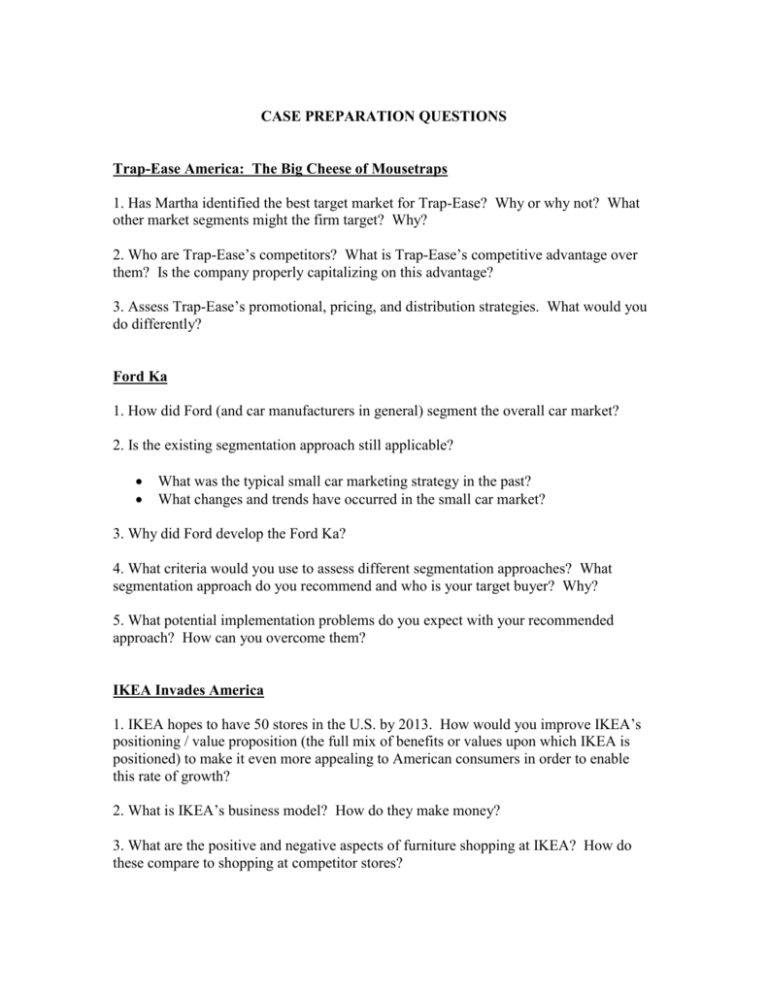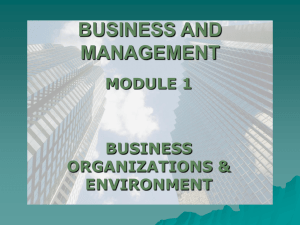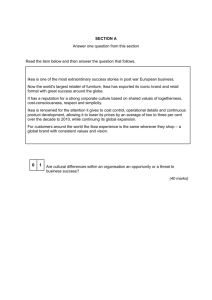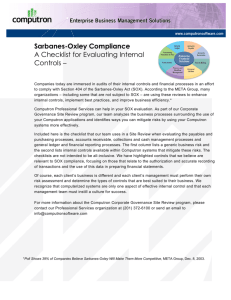document
advertisement

CASE PREPARATION QUESTIONS Trap-Ease America: The Big Cheese of Mousetraps 1. Has Martha identified the best target market for Trap-Ease? Why or why not? What other market segments might the firm target? Why? 2. Who are Trap-Ease’s competitors? What is Trap-Ease’s competitive advantage over them? Is the company properly capitalizing on this advantage? 3. Assess Trap-Ease’s promotional, pricing, and distribution strategies. What would you do differently? Ford Ka 1. How did Ford (and car manufacturers in general) segment the overall car market? 2. Is the existing segmentation approach still applicable? What was the typical small car marketing strategy in the past? What changes and trends have occurred in the small car market? 3. Why did Ford develop the Ford Ka? 4. What criteria would you use to assess different segmentation approaches? What segmentation approach do you recommend and who is your target buyer? Why? 5. What potential implementation problems do you expect with your recommended approach? How can you overcome them? IKEA Invades America 1. IKEA hopes to have 50 stores in the U.S. by 2013. How would you improve IKEA’s positioning / value proposition (the full mix of benefits or values upon which IKEA is positioned) to make it even more appealing to American consumers in order to enable this rate of growth? 2. What is IKEA’s business model? How do they make money? 3. What are the positive and negative aspects of furniture shopping at IKEA? How do these compare to shopping at competitor stores? 4. IKEA’s president has suggested that IKEA should open a number of smaller, satellite stores across the U.S. (e.g., in shopping malls, strip malls). By offering a limited range of IKEA products, these “IKEA Lite” shops would presumably give consumers who do not otherwise have access to a full-size IKEA the opportunity to experience the brand. What would you advise the president? Why? Colgate-Palmolive Company: The Precision Toothbrush 1. What changes are occurring in the toothbrush category? 2. How is the toothbrush market segmented? What benefits are consumers seeking in these segments? 3. What are the growth prospects in these segments? Assess the relative attractiveness of each of these segments. 4. What is your assessment of Colgate-Palmolive’s competitive position in the toothbrush category? 5. At which segment(s) should the Precision be targeted? (niche vs. mainstream) What should be Precision’s positioning? 6. Given your positioning decision, formulate a plan for the launch of Precision – branding, pricing, and message strategy. Skin-Tique Corporation 1. Is the aerosol package a good idea? 2. What are the economics (financials) of the 5-½ ounce tube container, 5-½ ounce aerosol, and the 10-ounce aerosol? 3. Assuming the research firm’s four forecasts shown in Exhibit 5 are reasonable, what incremental contribution can be expected in 2001 for the Soft and Silky brand for each forecast? 4. What are the pros/cons of commissioning the test market? Zenith Pet Foods, Inc. 1. How might one segment the dog food market and where does Show Circuit fit? 2. How would you position Show Circuit? 2 3. What is the market potential for Show Circuit? 4. What are the marketing program economics of Show Circuit? 5. What is your appraisal of the introductory promotion program? 6. Should the promotion program be accepted, rejected, or modified? Mountain Dew: Selecting New Creative 1. What are key success factors in the carbonated soft drinks category? More specifically, what are the strategic roles of branding, advertising, and sales promotion? 2. What is the strategic importance of the advertising “creative” (message) for Mountain Dew marketing? 3. Analyze the logic in the evolution of Mountain Dew’s advertising campaigns from the 1960s (“Yahoo! Mountain Dew!”) through the 1970s (“Hello Sunshine”) and up until the 1980s (“Country Cool”). 4. What were key cultural trends in the 1990s? How did these cultural trends get integrated and reflected in Mountain Dew’s advertising (“Do the Dew”) during that decade? Assess how effectively the various executions (“Done That,” “Mel Torme,” “007,” “Agassi,” “Thank Heaven,” “Jackie Chan,” “Parking Attendant”) capitalized on these trends. 5. What were new competitive dynamics by the end of the 1990s? How were these affecting the CSD category and Mountain Dew in particular? 6. Assess the Mountain Dew FY 2000 Brand Communications Strategy (Exhibit 7). 7. Which three new ads should be produced for FY 2000?? Consider the following in developing your analysis and recommendations: I. Alignment with Creative Strategy Is the ad “on strategy” per the brand communication strategy? Does the ad express brand benefits in a compelling manner? Does the ad evoke the brand’s symbolism? Does the ad effectively build on the brand’s equity? Does the ad build on previous ads in the campaign? 3 II. Execution Effectiveness Is the story understandable? Arresting? Entertaining? Is the ad creative? Original? Breakthrough? Memorable? Will the ad connect with its audience? Will the cultural references in the ad make sense to the target audience? Will the audience think that the ad is funny? Is the product integrated in the ad in a creative way? III. Super Bowl Placement How should you adjust your recommendation knowing that two of the ads will play on the Super Bowl? British Airways: “Go for It, America!” Promotion 1. In light of BA’s situation, evaluate the process of BA’s strategy development that led up to the “Go for It, America!” proposal. Did executives act appropriately given the circumstances and time pressures? What could they have done differently? Was there as great a crisis as BA perceived? 2. What is your appraisal of the strategic alternatives that BA considered in addressing the business downturn problem? Can you think of any other worthwhile options? 3. Appraise each of the five options. Assess both the concept and proposed implementation of the “Go for It, America!” program. 4. What reactions do you have to the questions raised about the program near the end of the case? 5. What recommendations would you make? Why? And Now, a Word from Our Sponsor 1. What are the pros and cons of product placement in this case? 2. What are the pros and cons of celebrity endorsement in this case? 3. What are legal and ethical considerations? 4. What would you do? 4 A Blogger in Their Midst 1. What’s the nature of the content of Glove Girl’s blogs? Are they advantageous or detrimental to Lancaster-Webb? 2. What’s Glove Girl all about? What are her motivations? 3. What’s so appealing about blogging? What is its downside? 4. Is Glove Girl an asset or a liability? 5. What options does Will have regarding Glove Girl? What would you do? Keeping to the Fairway 1. Was the Champions Tournament sponsorship a good sponsorship in the first place? Who are the sponsorship’s target audiences? 2. What would be the potential damage in continuing the sponsorship? Would it be long-lasting? 3. Are there other events with similar cachet and that would reach the right market? 4. If you were to discontinue the sponsorship, how would you implement the change? What would you say to clients, to employees, to the media? Mediquip S.A. 1. What went wrong here? 2. Is Thaldorf a good salesperson? Why or why not? 3. What should Thaldorf have done differently? What should Mediquip senior management have done differently? 4. Who was involved at Lohmann University Hospital in the purchase of a CT-scanner? What were their roles? Who had the power? Why did they decide not to purchase the Mediquip scanner? 5. What was Mediquip’s marketing strategy for its CT scanner? What’s the marketing problem here? Is it a strategy problem or a selling problem? 5 The Case of the Pricing Predicament 1. What kind of customer has Occidental Aerospace been to Standard Machine Corporation? 2. Why is Standard Machine in this predicament? What’s changed? 3. What do you think of Standard Machine’s fixed-price policy? Should they modify it for this deal? What are the pros and cons of such a move? 4. Who at Occidental Aerospace will make the ultimate buying decision? 5. What would you do differently if you found out that Akita is bidding an exceptionally low price to Occidental just to break into this account? Computron 1. What is Computron’s marketing strategy in Europe? 2. How important is Konig to Computron in West Germany? In Europe? What are Konig’s needs and motivations? 3. Do a profile of Computron’s key competitors. What are their goals and strategies? How important is Konig to them? What bids do you think they will make? 4. What price should you bid? Why? Cumberland Metal Industries 1. What’s your price for the curled metal pads? Why? (Make your price recommendation on a per pad basis instead of per set.) 2. How much do you think one of these pads is worth to a customer? What do the test data tell you about that? (Use the “Average Cost per Real Hour data—the last column in Table A – in quantifying CMI pads’ economic advantage. 3. How big is this market? What kind of an opportunity is this for us, anyway? 4. Who has to say “yes” before you sell a CMI pad? 5. How are you going to market these pads? Describe in detail the channel members, influences and others, and give us your plan. 6 Burroughs Wellcome Company: Retrovir 1. How would you describe the situation related to the AIDS epidemic in the U.S.A.? 2. How would you characterize the R&D efforts to develop Retrovir? 3. What arguments can be made on the basis of demand, cost, and competitive conditions to justify the pricing of Retrovir? 4. What arguments can be made on the basis of ethical grounds and a societal responsibility perspective for the pricing of Retrovir? 5. How profitable has Retrovir been for Burroughs Wellcome? 6. Should Burroughs Wellcome reduce the price of Retrovir below $120 for 100 capsules? If yes, why and when? If no, why not? Merton Industries: The Wholesale Distribution Decision 1. How would you characterize the carpet and rug industry, and Merton’s position in the industry? 2. What is Merton’s marketing strategy? (target, positioning, marketing mix) 2. What are the pros and cons of a wholesale vs. a company distribution system? 3. What are the economics of a company distribution system vs. wholesaler network? Financial Analysis Tips: In your calculations, make sure that the gross margin percentages and sales revenues that you are using are consistent with each other (i.e., wholesaler margins are applied to wholesaler sales revenues). Note that there are costs associated with financing or carrying accounts receivable. The case states that a 90-day collection period exists. Take this into account. Under the existing system, Merton finances wholesalers’ accounts receivable (“hidden cost”). If Merton goes with direct distribution, the company will assume additional inventory carrying costs at the warehouses, which it did not incur when it simply sold inventory to wholesalers. 7 Hendison Electronics Corporation 1. What has been Hendison’s marketing strategy to date? What’s different about Hendison’s new marketing strategy for 1997? 2. What is Hendison’s existing distribution strategy? How are the two types of dealers performing? [Note: Radio/TV specialty stores account for all of Hendison’s outlets—both exclusive and independent. Hendison products are not sold in department stores and mass merchandise stores.] 3. What are consumer requirements in purchasing home entertainment equipment? 4. What are retailers’ requirements for carrying and promoting home entertainment equipment? 5. How well does the current system fit the Hendison’s strategy, buyer and retailer requirements? 6. What are the pros and cons of the alternative distribution systems under consideration? What is the feasibility of achieving Hendison’s sales goal under each alternative? Which alternative would you select? U.S. Pioneer Electronics Corporation 1. What has U.S. Pioneer’s strategy been thus far? How would you evaluate this strategy? 2. What’s Bernie Mitchell’s problem? What’s the cause of it? 3. What’s going on in the market? Regarding the end-user? The trade (distributors)? 4. What are you going to do about Fast Eddie? Is he the wave of the future? 5. How will you take command of the channel? 6. What long-run strategic changes would you recommend for U.S. Pioneer given market evolution? 8 DISCUSSION QUESTIONS FOR CHAPTER READINGS Chapters 1, 2 1. What is “the marketing concept?” What does it mean to have a “customer-driven marketing strategy?” 2. What is the “marketing process,” i.e., the steps in developing marketing strategy? 3. What is marketing strategy? What is the marketing mix? Why is it called a “mix?” Be prepared to discuss the various marketing decisions associated with each element of the marketing mix. Cite examples. Chapters 7, 9 1. Explain the differences between segmentation, targeting and positioning. 2. What are the major bases for segmenting consumer markets? Cite examples. 3. How does one determine which market segment to target? 4. What is the significance of positioning to marketing strategy? 5. How do companies differentiate their products for effective positioning? Cite examples. Chapters 8, 11 1. What is a brand? What is brand equity? Come up with examples of brands that you think have high brand equity. How did they develop such high brand equity? 2. What are the advantages of high brand equity? 3. Is customer service the same as a service product? 4. What are characteristics of services that distinguish them from manufactured goods? 5. What are marketing strategies for these different service characteristics? Pick a service and illustrate your answers. Chapter 16 1. What steps are involved in developing an advertising campaign? 2. Explain the various communications mix tools. For what objective is each tool best suited? 9









